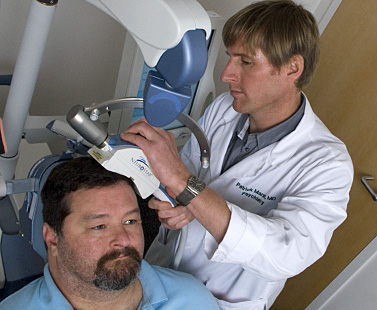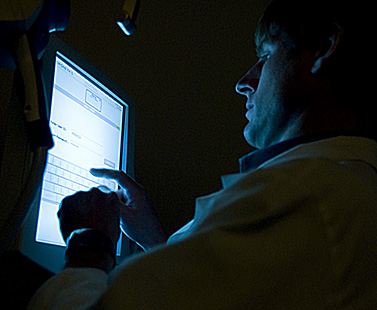Treatment offers new hope for those who have none

USF psychiatrist Dr. Patrick Marsh positions the Neurostar TMS device to the correct location on patient Lindsey Underwood’s head.
Lindsey Underwood has battled depression before.
But this time, it was worse. Blackness took over his world and sucked the joy from his life.
“It permeates every aspect of your life,” Underwood said. “It was very debilitating. I didn’t have the energy to get out of bed.”
And this time, when depression struck last year, anti-depressants didn’t help.
Underwood, a 44-year-old paralegal, was so desperate for help that he said good-bye to his wife and 2-year-old daughter in eastern Washington State and traveled across the country to get help from USF psychiatrists.
To be honest, Underwood said, he had doubts about the new treatment that USF doctors would give. Trans-cranial magnetic stimulation, or TMS, uses pulsed magnetic waves to stimulate cells in the brain.
“I was somewhat skeptical,” said Underwood. “Because the treatment sounds a little bit odd.”
Dr. Patrick Marsh, USF assistant professor in psychiatry, has heard such questions before.
“Everybody says, ‘Oh, that sounds like electroshock,’ ” he said. “So the TMS studies are fairly rigorous.”
Despite that frequent reaction, TMS has more in common with a completely different, and more familiar, technology: an MRI machine. And studies done so far show that TMS helps about half of patients tested feel significantly better. That track record is slightly higher than the percentage of people who are helped by anti-depressants, Dr. Marsh pointed out.
The patients who have been studied are those who, like Underwood, weren’t helped by anti-depressant drugs. The FDA approved the device, called the NeuroStar TMS Therapy System, to treat these patients in late 2008.
Underwood is among the converts. He’s still undergoing treatment, but said that TMS already has helped him. He began noticing a change after about 10 days of treatment, he said.
“I feel like the cloud of depression seems to have lifted,” Underwood said. “It doesn’t seem to color my every thought anymore.”

Trans-cranial magnetic stimulation, or TMS, uses pulsed magnetic waves to stimulate cells in a part of the brain linked to depression.
Dr. Francisco Fernandez, chairman of USF’s psychiatry department, is pleased by the results so far. With TMS, the department has added a powerful weapon to help patients who have no other alternative, he said.
“For patients with depression, the prognosis has not significantly improved in decades,” he said. “With TMS and other neuromodulation therapies, we hope to optimize treatment options and improve clinical outcomes for all.”
While the treatment is new, the idea is not. Doctors first experimented with treating depression by passing a magnetic coil over the brain in the early 1900s, Dr. Marsh said. Modern experiments with magnetic treatment began about 20 years ago, with the technology improving during that time.
The device uses magnetic pulses that are similar to those of an MRI machine. The treatment isn’t invasive, and patients don’t need anesthesia for treatment. It also has few known side effects.
“It’s the only treatment for depression that doesn’t include an FDA ‘black box’ warning,” noted Dr. Marsh.
The FDA requires that any drug that has the potential to cause a life threatening or serious adverse effect carry a warning by way of a black box. Antidepressants carry a ‘black box’ warning on the label informing patients that they may result in an increased risk of suicidal thoughts and behavior.
The Neurostar is made by Neuronetics, Inc., a privately held company based in Pennyslvania that has licensed a magnetic coil technology patented by Emory University. Dr. Marsh estimates that USF is one of about five places in Florida now offering TMS therapy.
“When you come to an academic medical center, you expect to be on the front lines of what is working,” Dr. Marsh said.
Making new treatments available and helping patients who haven’t been able to get help is a vital part of USF’s mission, said Dr. Fernandez.
“The mission of the department is to achieve excellence by delivering new treatments to enhance patient care,” Dr. Fernandez said. “We rely on the unique clinical expertise of our faculty and staff applying next-generation research and technology to improve the quality of life of our patients. By developing the Neurotherapies Clinic, and specifically with the use of TMS, USF has set a new standard of care for depression in our community.”
To receive TMS treatment, patients sit in a padded chair that looks like a dentist’s chair. A padded coil at the back holds the head steady. Treatments are aimed at a part of the brain that has been linked to depression, the left prefrontal cortex.
The psychiatrist finds this spot by first locating the motor strip of the brain, a narrow segment that runs roughly above the ear. The psychiatrist aims the NeuroStar TMS at the part of the motor strip that controls the thumb. The first time a patient receives treatment, it’s clear when this spot is located and stimulated: the thumb beings an involuntary, painless twitching.
The psychiatrist then moves the device forward on the head to locate the prefrontal cortex. Sometimes, patients find the sensation makes their scalp feel itchy or uncomfortable, but not painful. Patients get so accustomed to the feeling that some doze off during treatment, said Ruta Dimaite, director of the Neurotherapies Program.
Most patients receive 30 treatments, with five treatments each week for six weeks. Each treatment takes about 40 minutes.
For most people, the treatment has one big obstacle. Each session costs $350, and most insurance companies still don’t cover it.
“I have calls daily, and the biggest deterrent is the cost,” Dimaite said.
Both she and Dr. Marsh hope that insurance companies will begin to cover TMS as a treatment for depression.
“Depression is the most costly disease in terms of lost productivity,” Dr. Marsh said. “In a practical sense, that’s why there’s a big push to get insurance to cover it.”
For Underwood, the journey to find help has been worth it. While he misses his wife and daughter, his mother lives in Tampa, so he has been able to have a family member here during treatment.
Underwood has felt well enough to resume a regular exercise routine. He’s started reading again, and recently tackled Tom Wolfe’s novel A Man in Full. Both changes have made him feel even better.
It’s hard for people who have never experienced clinical depression to realize how difficult the condition is to cope with, he said.
“The general public thinks it’s ‘just a little blue,’ ” he said. “They don’t realize how profound it can be…It’s a sadness akin to trauma, like going through the death of a loved one, but it just won’t lift.”
Underwood decided to talk about his experience because he wants more people to learn that there are other treatment options available.
“It’s an alternative to medicine, to things that aren’t responding, and it’s not invasive,” he said. “It really can help.”

Dr. Marsh supervises a TMS treatment, a painless, non-sedating procedure that typically takes 40 minutes in an outpatient setting.
If you feel you, a friend or loved one may benefit from TMS Therapy, or you would like to refer a patient, please contact the Neurotherapies Program at (813) 259-0920 or email neurotx@health.usf.edu. Also, for more information, please visit: http://health.usf.edu/medicine/psychiatry/neurotherapy/.
— Story by Lisa Greene, photos by Eric Younghans,USF Health Communications

